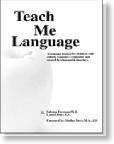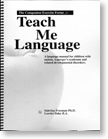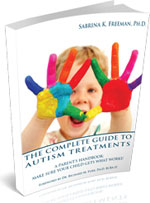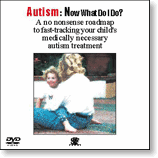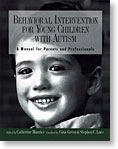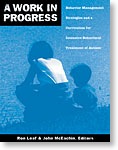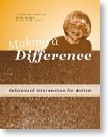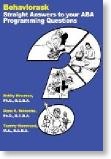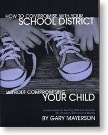science of sale
When A Government Report Supports a Lie
09/11/12 20:42 Filed in: autism | Asperger's Syndrome
I just finished reading Interventions for Adolescents and Young Adults with Autism Spectrum Disorders which is a government report that claims there is little scientific evidence supporting current autism treatments for teens with autism. The lead researcher is an Assistant Professor of Pediatrics and Special Education. The claim her study makes can be misused in very sophisticated ways to ration treatment for children once they reach the threshold of six years of age. The evil folks can do mischief because there is a grain of truth in a mountain of lies when it comes to research into autism treatment.
Researchers may have the best of intentions for people with autism; however, they help the “dark side” immeasurably when they do not provide context for their conclusions.
What’s the truth?
There are thousands of peer reviewed journal articles written in the field of Applied Behavior Analysis (ABA) in which adults with autism have been treated using a variety of techniques developed in this field. The data reported on adults generally uses a design which painstakingly measures behavior before, during and after the treatment of an individual with autism. Indeed, much of the science developed for comprehensive, early, intensive behavioral intervention is based on the foundations of this single-subject research in ABA. In the Interventions for Adolescents and Young Adults with Autism Spectrum Disorders report mentioned above, all single-subject design (SSD) studies were rejected because of the inclusion criteria that these researchers used. Here are their criteria:
Review Methods: We included studies published in English from January 1980 to December
2011. We excluded intervention studies with fewer than 20 adolescents or young adults with
ASD or fewer than 20 parents or family members of such individuals and studies lacking
relevance to ASD treatment.
Even if all the SSD studies are excluded, there are dozens of published between-subject, peer-reviewed journal articles presenting irrefutable evidence that intensive, behavioral treatment is best practices when it comes to autism treatment. However, none of these studies were included because, once again, this is a report on adolescents and young adults, not on children. In fact, the highest quality studies in the field of autism treatment were conducted on young children. Another hurdle that these studies must overcome regards number of participants per study. The inclusion criteria of these researchers creates the standard of at least twenty adolescents or young adults per study. This criterion acts to exclude most studies in the field because they are conducted with fewer participants.
Did Taylor and her research team search for studies on intensive behavioral interventions in adolescents?
Yes, they did. Here’s their statement:
Intensive Behavioral Interventions: Comprehensive intensive behavioral interventions that focus simultaneously on multiple target areas are quite common for preschool children with ASD (e.g., University of California, Los Angeles/Lovaas model and early intensive behavioral intervention variants, Early Start Denver model, parent training paradigms). Studies that use behavioral approaches in an intensive and comprehensive fashion are uncommon during adolescence and young adulthood, although some programs for older individuals with ASD (not included in this review) may use elements of comprehensive approaches (emphasis added).
In short, they couldn’t find studies using comprehensive intensive behavioral interventions on adolescents but they found plenty on children.
At this point there are thousands of children who continue to benefit from high fidelity Intensive Behavioral Treatment (IBT) into adolescence and adulthood. Children with autism benefitting from intensive, behavioral treatment do not somehow, suddenly cease to benefit due to age; rather, the problem, in my view, is that researchers typically do not follow these children into adolescence to demonstrate the continued effectiveness of intensive, behavioral treatment in large enough numbers to be included in the criteria of the Interventions for Adolescents and Young Adults with Autism Spectrum Disorders report.
Why is there a shortage of high-quality IBT studies with adolescents?
In a word: Ethics. In order to have a high quality studies, researchers need:
1) random-assignment to groups (which means one group of teens do not receive treatment).
2) longitudinal studies to see if gains are maintained.
Ethically, no child with autism should be denied effective treatment, particularly not into their teens! Therefore, based on the criteria that this report uses to define high quality studies, investigators studying intensive behavioral treatment will have a very difficult time meeting these criteria. Researchers, and those who are forced to fund treatment, will arrive at the erroneous, though possibly convenient, conclusion that IBT does not work for teens with autism. In short, our success with young children will lead to our failure with older children unless researchers find an ethical way to measure improvement with adolescents and young adults. That is an issue that must be addressed because if we cannot prove efficacy with a treatment that we know is successful, then we will relegate a generation of children with autism to a life of institutionalization and misery rather than freedom and dignity.
Researchers may have the best of intentions for people with autism; however, they help the “dark side” immeasurably when they do not provide context for their conclusions.
What’s the truth?
There are thousands of peer reviewed journal articles written in the field of Applied Behavior Analysis (ABA) in which adults with autism have been treated using a variety of techniques developed in this field. The data reported on adults generally uses a design which painstakingly measures behavior before, during and after the treatment of an individual with autism. Indeed, much of the science developed for comprehensive, early, intensive behavioral intervention is based on the foundations of this single-subject research in ABA. In the Interventions for Adolescents and Young Adults with Autism Spectrum Disorders report mentioned above, all single-subject design (SSD) studies were rejected because of the inclusion criteria that these researchers used. Here are their criteria:
Review Methods: We included studies published in English from January 1980 to December
2011. We excluded intervention studies with fewer than 20 adolescents or young adults with
ASD or fewer than 20 parents or family members of such individuals and studies lacking
relevance to ASD treatment.
Even if all the SSD studies are excluded, there are dozens of published between-subject, peer-reviewed journal articles presenting irrefutable evidence that intensive, behavioral treatment is best practices when it comes to autism treatment. However, none of these studies were included because, once again, this is a report on adolescents and young adults, not on children. In fact, the highest quality studies in the field of autism treatment were conducted on young children. Another hurdle that these studies must overcome regards number of participants per study. The inclusion criteria of these researchers creates the standard of at least twenty adolescents or young adults per study. This criterion acts to exclude most studies in the field because they are conducted with fewer participants.
Did Taylor and her research team search for studies on intensive behavioral interventions in adolescents?
Yes, they did. Here’s their statement:
Intensive Behavioral Interventions: Comprehensive intensive behavioral interventions that focus simultaneously on multiple target areas are quite common for preschool children with ASD (e.g., University of California, Los Angeles/Lovaas model and early intensive behavioral intervention variants, Early Start Denver model, parent training paradigms). Studies that use behavioral approaches in an intensive and comprehensive fashion are uncommon during adolescence and young adulthood, although some programs for older individuals with ASD (not included in this review) may use elements of comprehensive approaches (emphasis added).
In short, they couldn’t find studies using comprehensive intensive behavioral interventions on adolescents but they found plenty on children.
At this point there are thousands of children who continue to benefit from high fidelity Intensive Behavioral Treatment (IBT) into adolescence and adulthood. Children with autism benefitting from intensive, behavioral treatment do not somehow, suddenly cease to benefit due to age; rather, the problem, in my view, is that researchers typically do not follow these children into adolescence to demonstrate the continued effectiveness of intensive, behavioral treatment in large enough numbers to be included in the criteria of the Interventions for Adolescents and Young Adults with Autism Spectrum Disorders report.
Why is there a shortage of high-quality IBT studies with adolescents?
In a word: Ethics. In order to have a high quality studies, researchers need:
1) random-assignment to groups (which means one group of teens do not receive treatment).
2) longitudinal studies to see if gains are maintained.
Ethically, no child with autism should be denied effective treatment, particularly not into their teens! Therefore, based on the criteria that this report uses to define high quality studies, investigators studying intensive behavioral treatment will have a very difficult time meeting these criteria. Researchers, and those who are forced to fund treatment, will arrive at the erroneous, though possibly convenient, conclusion that IBT does not work for teens with autism. In short, our success with young children will lead to our failure with older children unless researchers find an ethical way to measure improvement with adolescents and young adults. That is an issue that must be addressed because if we cannot prove efficacy with a treatment that we know is successful, then we will relegate a generation of children with autism to a life of institutionalization and misery rather than freedom and dignity.


